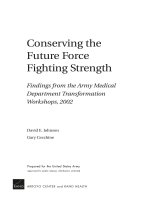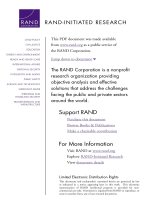time to heal american medical education from the turn of the century to the era of managed care
Bạn đang xem bản rút gọn của tài liệu. Xem và tải ngay bản đầy đủ của tài liệu tại đây (2.69 MB, 541 trang )
TIME TO HEAL
Time to Heal
American Medical Education
from the Turn of the Century
to the Era of Managed Care
Kenneth M. Ludmerer
1
1999
1
Oxford New York
Athens Auckland Bangkok Bogotá Buenos Aires
Calcutta Cape Town Chennai Dar es Salaam Delhi
Florence Hong Kong Istanbul Karachi Kuala Lumpur
Madrid Melbourne Mexico City Mumbai Nairobi Paris
São Paulo Singapore Taipei Tokyo Toronto Warsaw
and associated companies in
Berlin Ibadan
Copyright © 1999 by Oxford University Press, Inc.
Published by Oxford University Press, Inc.
198 Madison Avenue, New York, New York 10016
Oxford is a registered trademark of Oxford University Press, Inc.
All rights reserved. No part of this publication may be
reproduced, stored in a retrieval system, or transmitted,
in any form or by any means, electronic, mechanical,
photocopying, recording, or otherwise, without the
prior permission of Oxford University Press.
Library of Congress Cataloging-in-Publication Data
Ludmerer, Kenneth M.
Time to Heal : American medical education from the turn of the
century to the era of managed care / Kenneth M. Ludmerer.
p. cm. Includes bibliographical references and index.
ISBN 0-19-511837-5
1. Medical education—United States—
History—20th century. I. Title.
II. Title : American medical education from the
turn of the century to the era of managed care.
[DNLM : 1. Education, Medical—history—United States.
2. History of Medicine, 20th Cent.—United States.
W 18 L945t 1999]
R745.L843 1999 610'.71'1730904—dc21
DNLM/DLC for Library of Congress 98-55496
135798642
Printed in the United States of America
on acid-free paper
For Loren
Contents
Preface xi
Acknowledgments xv
Introduction xix
Part I Fulfilling the Social Contract: Medical Education as a
Public Trust and the Capture of Public Confidence
1. Creating the System 3
Progressive Medical Education
Fund-Raising
Medicine and the University
The Emergence of the Teaching Hospital
Establishing the Social Contract
2. The American Medical School Between the World Wars 26
Education
Research
Patient Care
Faculty Culture
Diversity and Development
The Rise of Harvard Medical School
3. Undergraduate Medical Education 59
Admissions
Training for Uncertainty
The Hidden Curriculum
Student Life
The Limits of Education
4. The Rise of Graduate Medical Education 79
The Creation of Internship and Residency
From Supervision to Responsibility
Selecting House Officers
Stresses and Support
Graduate Medical Education and the Public Interest
5. Teaching Hospitals 102
Joining the University
The Presence of Time
The Ward Service
6. Academic Medical Centers and the Public 114
Town and Gown
The Care of the Poor
Medical Education and the Nation’s Health
7. World War II and Medical Education 125
Mobilization for War
The War Against Disease
The Apotheosis of Medical Optimism
Part II Medical Education in the Era of the Multiversity:
The Growth of Research and Service in a Period
of Abundance
8. The Ascendancy of Research 139
The Age of Federal Beneficence
Changing Intellectual Directions
The Decline of Academic Gentility
9. The Expansion of Clinical Service 162
Academic Medical Centers and the Rising Demand for Medical Care
The Persistence of Academic Values
The Preservation of the Learning Environment
10. The Maturation of Graduate Medical Education 180
The Democratization of Residency
The Rise of Subspecialty Training
The Changing Life of the House Officer
11. The Forgotten Medical Student 196
The Evolving Curriculum
The Changing Medical Student
Producing More Doctors
The Devaluation of Teaching
viii CONTENTS
Part III Breaking the Social Contract: The Erosion of University
Values, the Decline of Public-Spiritedness, and the
Beginning of the Second Revolution
in Medical Education
12. Medicare, Medicaid, and Medical Education 221
The Escalation of Faculty Practice
Toward a One-Class System of Care
The Inversion of University Ideals
13. Medical Education in an Era of Protest and Civil Rights 237
Student Activism
House Staff Militancy
Minorities
Women
14. Academic Health Centers Under Stress: External Pressures 260
The Decline of the Cities
Competition for Patients
The New Adversarial Relationship with Government
The Dawn of the Age of Limits
15. Academic Health Centers Under Stress: Internal Dilemmas 288
Molecular Medicine and the Disappearance of Teachers
Reform Without Change
The Dilemmas of Graduate Medical Education
16. Internal Malaise 327
Rudderless Ships
The Decline of Academic Health Centers as Public Trusts
17. Medical Education in an Era of Cost Containment and
Managed Care 349
Vassals of the Marketplace
The Loss of Time and the Erosion of the Learning Environment
Proactive Words; Reactive Behavior
18. A Second Revolutionary Period 370
The Reemergence of a Proprietary System
The Declining Relevance of Medical Education
Restoring the Social Contract
Notes 401
Index 495
CONTENTS ix
Preface
T
his book was written with two objectives in mind. The first was
to provide a comprehensive interpretive history of American medical
education from the beginning of the twentieth century through the
present. The second was to alert readers to changes the marketplace has
exerted on the way doctors learn and practice medicine in the current era
of “managed care.” Thus, the story relates to the larger practice of medi-
cine and to many current anxieties about health care in America among
patients, health care professionals, and the public.
It would have been impossible for me to have conceptualized this
book without the experience of having written an earlier book on medical
education, Learning to Heal: The Development of American Medical Education
(Basic Books, 1985), which examined the creation of the country’s system
of medical education from the Civil War through World War I. In this
sense, work for the present volume began in 1976. However, the need for
another book became apparent to me in the late 1980s as the managed
care movement began to spread rapidly. Many medical schools and
teaching hospitals were no longer receiving enough clinical income to
allow their educational and research programs to be fully supported.
More subtle but more important, the learning environment for medical
students and house officers was eroding, and professional values in med-
ical practice were being marginalized. The origins of these dilemmas pre-
ceded the 1980s and could not be explained just by a hostile marketplace.
Rather, they arose in part from actions (or inactions) within academic
medicine itself during the second half of the century. This book repre-
sents an effort to help understand these events.
The most important sources for this book were unpublished records
from medical schools, hospitals, faculty members, administrators, stu-
dents, and various private and public organizations. These sources pro-
vided rich detail obtainable in no other fashion. During my research, I
xi
visited a representative sample of approximately one-quarter of the
country’s academic medical centers. If certain institutions are represented
more frequently in the text, it is usually because their archival holdings
were more extensive. In general, records became particularly voluminous
for the period after 1965, illustrating one of the daunting problems of
researching contemporary history. (For example, the minutes and agenda
items of the Executive Council of the Association of American Medical
Colleges from 1932 to 1956 were contained in one storage box; the records
from 1957 to 1991 required 42 boxes.) The notes to the book are purposely
long for the benefit of interested readers. However, the book may be read
without returning to the notes, and no one need be distracted by them.
At the beginning of the project it quickly became apparent that the
evolution of medical education in America could not be fully understood
without being placed in a broad social and cultural context. Thus, I also
read extensively in social, cultural, and educational history and medical
sociology. The notes serve as a guide to the secondary literature to which
I owe so much. It did not lessen my interest in the subject to discover that
the history of medical schools and teaching hospitals was in fact a prism
of many of the social, cultural, and political forces transforming Ameri-
can society as a whole during the twentieth century.
This book has been crafted so that chapters and sections may be read
individually without having to read what precedes or follows. However,
the chapters are tightly interrelated, and I hope that readers will find that
the narrative is more than the sum of the parts. Every measure has been
taken to assure accuracy. Given the rapid-fire changes of the current
health care environment, it would be surprising if certain details dis-
cussed in Chapters 17 and 18 did not become outdated during the time it
took to publish the book—perhaps a new merger between teaching hos-
pitals or medical schools, or a previously announced merger falling
apart. However, such epiphenomena will not alter the nature of the trans-
forming forces, the challenges and opportunities American medical edu-
cation faces for the twenty-first century, or the choices that we as a society
will have to make about our health care system in the future. Thus, read-
ers should find the analysis provided in the last two chapters to be
salient, even if the landscape should appear slightly different in the near
future.
Throughout the narrative I have endeavored to be objective and bal-
anced so that the book might be useful to those of divergent viewpoints
about how American medical education and practice should proceed.
Those looking to divine the future by reading these pages will be disap-
pointed. The past did not occur in an inevitable or predictable fashion;
neither will the future. However, the past bears powerfully on the present
in American medicine. Thus, it is my hope that this historical analysis
will help illuminate the current dilemmas we face and provide guidance
as we make choices about the future of our health care system.
The title of the book conveys a dual meaning. An overarching theme of
xii PREFACE
the book is the importance of time to every aspect of good medicine. Suf-
ficient time is required to learn to heal, to teach how to heal, to practice
the art of healing, and to discover new ways to heal. During the current
managed care era, time is being squeezed out of each of these activities,
which is perhaps the most alarming transformation of all those occurring
in American medicine at the present moment. In addition, though both
the profession and public at large have recently experienced profound
angst about medical education and practice, a historical understanding of
the creation of these dilemmas suggests ways out of the predicament.
Thus, it is also time to use this knowledge to begin healing our ailing sys-
tems of medical education and practice while they are still superb—and
salvageable.
PREFACE xiii
Acknowledgments
A
t the end of a long journey, it is a great pleasure to thank the
many persons whose encouragement, advice, and support were so
instrumental along the way. While writing this book, I have been unusu-
ally fortunate in the assistance I have received from friends and col-
leagues. Their generous contributions have immeasurably enriched the
final product.
Research for the book involved years of travel to scholarly repositories
throughout the country, and I am indebted to the many archivists and
librarians who aided and encouraged me during this demanding and
seemingly endless stage of the project. The notes will serve as an index to
the dozens of staffs that so graciously provided assistance. I am espe-
cially grateful to Adele Lerner, who at the start of the project guided me
through the linear mile of records at the New York Hospital–Cornell
Medical Center, and to Susan Crawford, Mark Frisse, and Paul Anderson
of the Washington University Medical School Library. I would also like to
thank the Rockefeller Archive Center and American Philosophical Soci-
ety for grants-in-aid that facilitated some of the early travel.
Much of the research, particularly for the most recent decades, was
conducted in the offices of medical school deans and hospital presidents,
where I was typically the first scholar ever to examine the materials. I was
surprised—and inspired—by the willingness of medical school and hos-
pital officials to make their most confidential records open to my inspec-
tion. So free was my access to the materials that I was often the one to
lock up the office at night. Such willingness among medical educators to
allow themselves to be scrutinized, despite knowing that not all that
would be found would be flattering, served as a remarkable indication of
their commitment to meeting the current challenges in health care deci-
sively and constructively.
During both the research and writing, I benefited from the support and
xv
suggestions of many friends and colleagues, who were always available
for conversations and musings. I would especially like to thank Garland
Allen, Paul Beeson, Henry Berger, Iver Bernstein, Morton Bogdonoff, Ger-
ald Dunne, Mary Ann Dzuback, I. Jerome Flance, Donald Fleming, Renée
Fox, Mark Frisse, Thomas Gallagher, Daniel Goodenberger, Jack Hexter,
Harry Jonas, Michael Karl, David Kipnis, David Konig, Joseph Losos,
Gerald Perkoff, Henry Schwartz, Monte Throdahl, Peter Tuteur, Richard
Walter, and Carl Wellman. I have been touched and inspired by these and
other individuals in ways they probably do not even realize. I also
learned much from serving on a task force on medical education spon-
sored by the Acadia Institute during a formative stage of the project.
A number of colleagues generously took the time to read all or parts of
an earlier version of the book. I would like to thank Paul Beeson, Iver
Bernstein, Gert Brieger, Roger Bulger, Mary Ann Dzuback, Donald
Fleming, Renée Fox, Mark Frisse, Thomas Gallagher, Daniel Good-
enberger, Hugh Hawkins, Diane Katzman, Joseph Kett, David Kipnis,
Gerald Perkoff, Linda Sage, Rosemary Stevens, Monte Throdahl, and
Michael Whitcomb for their helpful and insightful comments. I am
equally grateful to the scholars who participated in a conference in March
1997 to discuss an earlier version of Part III of the book, as well as to the
Milbank Memorial Fund for arranging the meeting. I would also like to
thank Marietta Magnus for the faithful secretarial and computer assis-
tance she provided and Jeffrey House of Oxford University Press for his
constructive suggestions, sage advice, and steady encouragement.
To a few persons I would like to express my special appreciation.
Daniel Fox was a source of encouragement and ideas throughout the pro-
ject. His suggestions on how to strengthen the preliminary manuscript
were invaluable, and he became a friend of the book in the broadest pos-
sible ways. Ralph Morrow was a continual source of encouragement,
advice, and wisdom. Throughout the project we talked regularly, and he
offered many helpful suggestions on the preliminary manuscript. In addi-
tion, whenever I was stuck, he was available, which was fortunate for me
since he was someone whose judgment I particularly trusted. Jordan,
Lindsey, and Cissy Ludmerer enriched the book by their presence. Loren
Ludmerer was a fountainhead of ideas, guidance, and encouragement,
and her many insightful comments and suggestions improved the book
enormously. In addition, she contributed to the project in many diverse
and important ways that only authors can fully understand.
The most difficult part of the project involved the decision to carry the
story through the present and to write a book that spoke to many of the
large anxieties of today’s health care world. Had the narrative ended with
Chapter 16, the book would have been ready for publication two or three
years earlier. In this context, I am extremely grateful to the Washington
University Department of Medicine for providing an unusually support-
ive environment that allowed me to undertake a large project where suc-
cess was not guaranteed. I am also indebted to a number of private foun-
xvi ACKNOWLEDGMENTS
dations for the indispensable financial support they provided: the Henry
J. Kaiser Family Foundation, the American Medical Association Founda-
tion, the Charles E. Culpeper Foundation, the Spencer Foundation, and
especially, the Josiah Macy, Jr. Foundation. These organizations accepted
the notion that it would be important to have a study that examined and
analyzed medical education from a broad point of view. My hope is that
they will feel that their trust has been justified.
ACKNOWLEDGMENTS xvii
Introduction
I
t is hardly an accident that the twentieth century has been called
“the health century.” Americans have been blessed with a soaring life
expectancy, declining infant mortality, control of the infectious and nutri-
tional diseases that have ravaged the human race throughout recorded
history, and important advances against modern-day killers like cancer,
coronary artery disease, and stroke. Technological marvels such as com-
puter-guided scanners and organ transplantation have astonished and
amazed the public, as have remarkable breakthroughs in genetic medi-
cine and biotechnology. It is difficult to know which seems more like sci-
ence fiction: the recent cloning of a sheep (and the prospect of cloning
human beings), or the World Health Organization’s expansive definition
of health as the presence of physical, mental, socioeconomic, and spiri-
tual well-being, not the absence of sickness.
No factor has been more important to the achievements of medical
practice in the United States than the country’s medical schools and
teaching hospitals (or academic health centers, as the joint institutions are
typically called). Their importance lay in the education of the nation’s
doctors, generation of new medical knowledge, introduction and evalua-
tion of innovative clinical practices, and provision of the most sophisti-
cated medical care available. During most of the twentieth century, an
admiring public obligingly catered to their needs, and the institutions
accordingly prospered. Nevertheless, academic health centers also grew
insular, and at century’s end the public was withdrawing much of its tra-
ditional support of them. As the millennium approached, medical
schools and teaching hospitals were in jeopardy, with disturbing implica-
tions for the future quality of medical care in America. It is this paradox
of academic health centers—that they were so successful, so central to the
xix
nation’s health, and ultimately so threatened—that is the central concern
of the story told in the following pages.
❦
•
❦
•
❦
This book is intended to provide a synthetic history of American medical
education from the turn of the twentieth century through the present. A
major focus is the four years of medical school—the period of undergrad-
uate medical education. However, the book explores many other topics,
such as premedical training, admissions, residency and specialty educa-
tion (graduate medical education), the institutions of medical training,
and the complex interactions between academic health centers and the
society they were created to serve. The story includes such issues as the
financing of medical education, the expansion of medical research, the
creation of new medical schools, the problems encountered by minority
and women students, the changing relationship between teaching and
research, the difficulty of retaining the art of medicine in a technological
age, the erosion of medical education’s traditional patient base, the grow-
ing tension between egalitarian and educational ideals, and the complex
relationships between medical schools and teaching hospitals, medical
schools and universities, and academic health centers and their sur-
rounding neighborhoods.
This history is very much a study of people, not just institutions. A pri-
mary objective is to recapture the experience of students, house officers,
faculty, administrators, and patients and to describe how their day-to-
day lives in the medical world have evolved over the course of a century.
Similarly, the book examines the relationships among these various
groups, such as how faculty have established authority over students and
house officers, how those in training have prodded their instructors to
remain intellectually honest, how learners have coped with the some-
times brutal training conditions, and the ways in which the relationships
between students and patients have changed. The book also examines
certain unseemly events in the history of medical education, such as
admission quotas and the ongoing tensions between “town” (community
physicians) and “gown” (medical faculties).
Traditionally, most writings in the history of medicine have empha-
sized either the intellectual development of medicine (the “internalist”
approach) or the social, economic, and political context of medicine (the
“externalist” approach). This book is characterized by the attempt to
incorporate both perspectives. Important to this discussion are the
changes in medical education and practice that have resulted from the
internal development of medicine, particularly the increasing reduction-
ism (molecular level of analysis) of medical knowledge. However, the
book also interprets medical education in its external context: higher edu-
cation in America, the evolving health care delivery system, and the
major cultural trends of the twentieth century.
xx INTRODUCTION
A strong sociological perspective also pervades the book. A striking
observation is that the power of medical education is limited, particularly
regarding its ability to produce doctors who are caring, socially responsi-
ble, and capable of behaving as patient advocates in all practice environ-
ments. Indeed, much of the behavior of physicians reflects influences
from outside the medical school, such as the character and values of
those who choose to enter medicine, the cultural climate of the time, and
the particular rewards and incentives offered by medical practice. It is
important to recognize that the caliber of doctors we have represents a
negotiation between medical education and society. Our physicians
reflect the type of people and society we are, not just the efforts of acade-
mic health centers. It would not be an exaggeration to say that as a nation
we ultimately get the type of doctors we deserve.
In view of the many similarities among medical schools, it is possible
to speak in these pages of American medical education as a whole. All
schools must conform to uniform standards to receive accreditation, all
teach the same corpus of knowledge, and graduates of all schools are
entitled to practice anywhere in the United States. However, it is equally
important to recognize the striking diversity that exists among medical
schools. Some are private, others public. Most utilize major teaching hos-
pitals for their clinical work, but many new schools use smaller commu-
nity hospitals. The level of research activities varies markedly from one
school to another, as does the commitment to special missions, such as
the production of primary care practitioners or the education of racial
minorities. No school is without its distinctive local traditions. This dual
perspective of commonality and individuality is important to under-
standing American medical schools fully, even if it is not possible in this
book to provide an account of each school.
It is sometimes tempting to interpret the evolution of American
medical education as the response of medical schools and teaching hos-
pitals to powerful external forces: the Depression, World War II, the
National Institutes of Health, private medical insurance, Medicare and
Medicaid, and the managed care movement. This view is only partially
correct, for individuals also mattered. This fact goes a long way toward
explaining the relative professional ascent of some schools and relative
decline of others. It would be a great error to view the history of Ameri-
can medical education as devoid of people or personalities.
Precisely because individuals were important, American medical edu-
cation did not develop in a predictable or inevitable fashion. At every
point choices were made—some with good results, others with less salu-
tary consequences. If American medical schools and teaching hospitals
were in a precarious position at the end of the century, it was not because
anyone desired to do them harm but because poor decisions were made
or unforeseen consequences occurred. Nevertheless, for those who wish
to do so, opportunities to influence medical education in a more con-
INTRODUCTION xxi
structive direction are still present. The lesson of history is that the future
is not predetermined and that individuals can make a difference.
❦
•
❦
•
❦
In view of the book’s broad scope, it may be useful to identify the major
themes.
By World War I, the modern medical school and teaching hospital
in the United States had been created, and the first revolution in Ameri-
can medical education (often called the “Flexnerian” revolution, after
Abraham Flexner, the author of an influential report on medical educa-
tion in 1910) was complete. This revolution called for medical schools to
be university-based, for faculty to be engaged in original research, and
for students to participate in “active” learning through laboratory study
and real clinical work. The origins of the revolution dated to the mid-
nineteenth century, when a revolution occurred regarding how medicine
should be taught. Subsequently, this intellectual revolution begot a social
and economic revolution that allowed the new educational ideas to be
implemented. During the revolution an implicit social contract was
established. Society would provide the necessary financial, political, and
moral support of medical education and research. In exchange, medical
faculties would remember that they existed to serve, and the measure of
their success would be the quality of their academic work and their suc-
cess at ensuring that medical practice in America was conducted accord-
ing to high, professionally determined standards.
From the beginning, the modern American medical school had a tri-
partite mission: education, research, and patient care. However, the rela-
tive importance of these activities varied with time. From World War I to
World War II, the educational mission was paramount. Teaching was the
end in itself, and patient care was pursued only insofar as it was needed
to facilitate teaching. Faculties prided themselves on providing an edu-
cational environment that focused on the needs of learners, a group that
expanded during this time to include interns and residents as well as
medical students.
As medical faculties taught, they also engaged in research. By the
1930s the United States had become the foremost nation in medical
research in the world. After World War II, however, research replaced
teaching as the dominant activity of most medical faculties. This resulted
primarily from the expansion of the National Institutes of Health. By
1965, federal grants and contracts typically accounted for 60 percent or
more of the budgets of research-intensive medical schools. However, all
medical schools shared in the wealth, and at virtually every school, the
research enterprise grew to a size that before the war would have been
considered unimaginable.
As the period from World War I to World War II was the educational
era, and that from World War II to 1965 the research era, the period after
xxii INTRODUCTION
1965 was the clinical era. Since the 1940s, with the spread of private med-
ical insurance in the United States, medical faculties had increasingly
engaged in the private practice of medicine. However, after the passage
of Medicare and Medicaid in 1965, the amount of faculty practice began
to soar, as millions of “ward” (charity) patients became paying patients
overnight. Within 15 years, the size of the clinical enterprise eclipsed that
of the academic enterprise at virtually every school, and faculties typi-
cally generated 50 percent or more of their income from private practice.
Clinical revenue allowed an extraordinary expansion of faculty sizes and
salaries, particularly in the clinical departments.
During each of these three eras, medical schools experienced enor-
mous growth. In 1910, a leading medical school might have had a budget
of ›100,000. By 1940, that budget typically had grown to ›1,000,000; by
1965, to ›20,000,000; and by 1990, to ›200,000,000 or more. At most
schools, growth was unplanned and by accretion, with new programs
piling on top of existing ones. By the 1980s, medical schools were no
longer cohesive organizations. Education, research, and patient care,
once interrelated activities held in some sort of balance, had each been
magnified to the point that they could no longer be readily balanced
with each other.
As medical schools grew, a number of conspicuous changes occurred.
The education of medical students, once the central mission of medical
schools (and their one unique activity), was no more than a by-product
of what contemporary academic health centers were doing in the 1980s.
Throughout the century, medical schools had been situated in part in the
university and in part in the health care delivery system. Now, the med-
ical school’s ties to the university had significantly weakened, while its
involvement in the health care delivery system had correspondingly
grown. During the course of the century, academic health centers had
evolved primarily in a faculty-driven fashion, as opposed to a style that
concentrated on the needs of learners or the wishes of society for medical
schools to help improve the health care delivery system.
Though education by the 1980s was rarely a high institutional priority,
the quality of medical education obtainable in the United States
remained superb. This was because all medical learning was ultimately
self-learning. Throughout the century, the high quality of American med-
ical education depended far less on the formal curriculum than it did on
attracting motivated, capable students and providing them unfettered
opportunities to learn. Essential to this learning environment were good
laboratories and libraries, an ample and diverse supply of patients, and
stimulating teachers and colleagues. Most important of all was the fact
that medical education was conducted in settings where learners were
provided sufficient time with patients so that patients could be studied
and understood.
In the 1980s and 1990s, with the spread of the managed care move-
INTRODUCTION xxiii
ment, the supportive environment for academic health centers rapidly
began to change. Managed care (a generic term encompassing a variety
of new approaches to financing and delivering medical care) arose as
an attempt to correct serious, long-standing problems in the health
care delivery system. Soon, however, many problems with managed care
also became apparent, among which were its deleterious effects on acad-
emic health centers. Managed care organizations insisted on paying the
lowest possible price for medical care. In this new environment, acade-
mic health centers, which had higher costs than community hospitals
because of education, research, charity care, and certain highly spe-
cialized clinical services, suddenly found their financial viability threat-
ened.
Specific responses of academic health centers to this situation varied,
but the general thrust was to expand their clinical enterprises still further
so that they might make up in volume what they were losing in price.
More patients could be seen if faculties treated patients more quickly—
by decreasing the length of stay and increasing the turnover of inpa-
tients, or by brief, rapid-fire office visits for outpatients. Medical school
and teaching hospital officials, who once measured their success by
the physicians they educated and the new knowledge they produced,
now increasingly focused on their institution’s profitability and market
share, with scant discussion of what was happening to education and
research.
By the late 1990s, it was clear that the competitive, market-driven
response of most faculties was generally successful in terms of maintain-
ing or even increasing clinical income. However, in the process, the qual-
ity of academic work at most schools began to suffer. At many schools,
clinical teachers and investigators were forced to spend more and more
time seeing patients, sometimes to the near abandonment of their educa-
tional responsibilities. More insidious and more serious, the increasing
speed with which patients were treated wreaked havoc on the learning
environment of academic health centers, whose quintessential feature
had always been that it had allowed students and house officers enough
time with patients for educational objectives to be met. Equally disturb-
ing were the potential long-term effects of educating the nation’s doctors
in a commercial atmosphere where the good visit was a short visit,
where patients were “consumers,” and where institutional officials
spoke more often of the financial balance sheet than of service and the
relief of suffering. Such an environment did little to validate the altruism
and idealism that students typically brought with them to the study of
medicine.
Ironically, in the 1990s it became apparent that what was good for
medical schools and medical faculties was not necessarily good for med-
ical education. Schools could remain financially strong and continue to
xxiv INTRODUCTION









